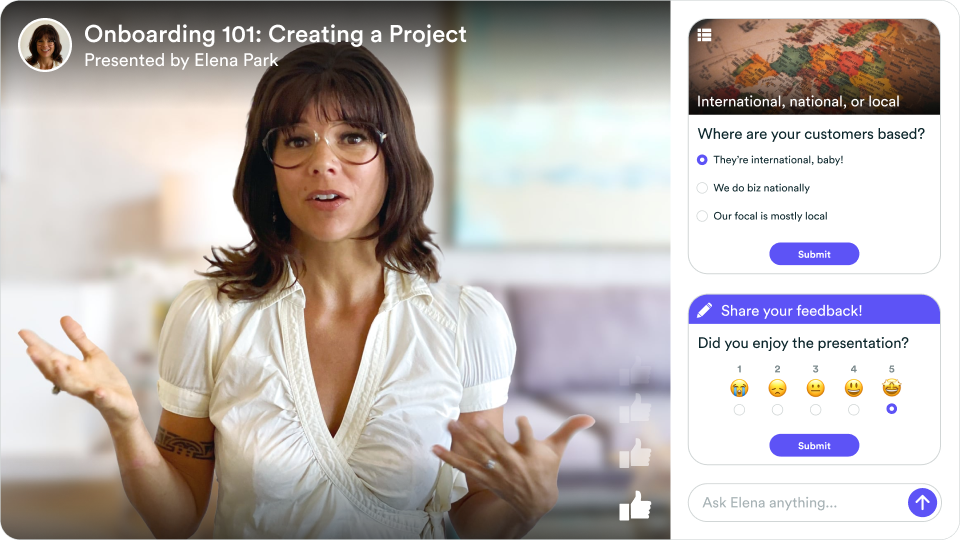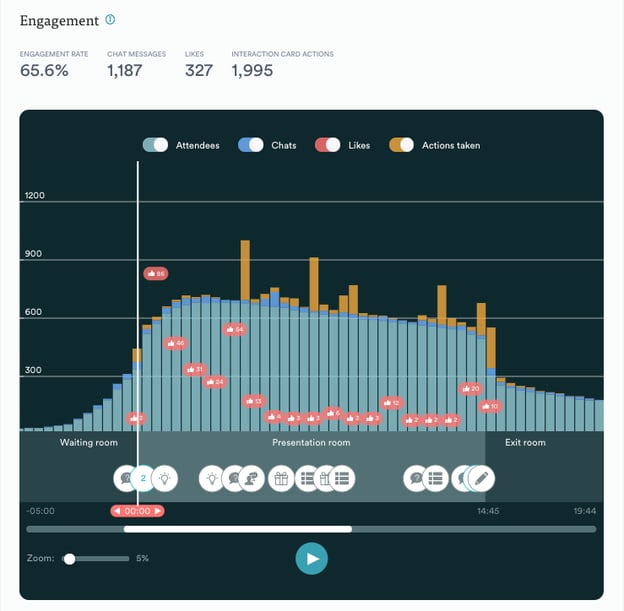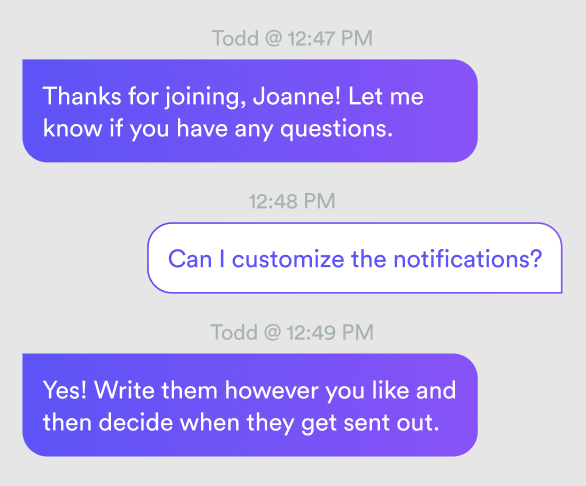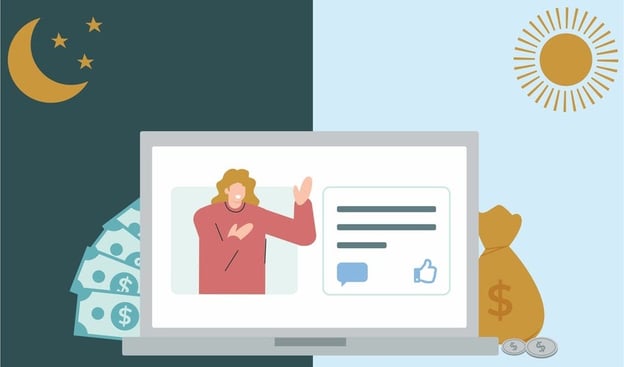Automated Webinar vs Video on YouTube: What’s the Difference?
“If an automated webinar is a video delivered as a webinar, how is it different from hosting a video on YouTube or Vimeo, embedding it on a landing page, and sharing it with prospects and customers? At the end of the day, aren’t they both just videos?”
“Why make people go through the hassle of registering for a webinar when it’s pre-recorded? Why throw up that unnecessary barrier?”
If you’ve been investigating automated webinars and considering whether or not you should use them to deliver your video content, you are probably asking yourself these questions. While the answers ultimately depend on your goals, for certain kinds of video content, the benefits of automated webinars far exceed what you can get from simple video, so much so you may find it hard to imagine doing it any other way once you understand the difference.
Here is what is covered in this article if you’d like to skip ahead:
- The kinds of videos that work well as automated webinars
- When video is a better option than an automated webinar
- 6 core benefits of automated webinars
- 14 key differences between hosted video and automated webinars
- How to A/B test a video and an automated webinar
The kinds of videos that work well as automated webinars

To know if your videos (or the ones you hope to produce) are good candidates for automated webinars, ask yourself these questions:
- Would it tangibly help your business if you could get customers to commit to watching your videos from beginning to end?
- Are your videos 5 minutes long or longer?
- Did you make the videos to replace or scale presentations that you otherwise would have given over and over again?
- Do your videos focus on training, onboarding, or sales?
- Would it help your business if customers could easily reach out to you during one of your videos, ask questions, and engage in a chat conversation with you? (Don’t worry about the logistics of this!)
- Is one of your goals to establish or nurture relationships with the people who watch your videos?
- Would you like to be able to capture leads and ultimately generate revenue from your videos?
- Would you like to be able to know if people actually watched your videos?
- Would you like to be able to collect direct feedback from those watching your videos so you can improve your product, your service, or your content?
If you answered yes to even one of these questions, automated webinars — hosted using a tool like eWebinar – could be a powerful vehicle for sharing your video content with the world. If you answered yes to more than one, it’s probably a slam dunk.
Do webinars really work? To get a deeper understanding of the effectiveness of webinars and the results companies get from them across industries, check out this study from CloudIncome.
The benefits you get from a webinar (that you can't from a video) come from the nature of webinars themselves, whether live or automated.
Webinars are events. People make time and block off their calendars in order to attend. To keep from missing anything, they show up on time and stay till the end, provided the content is good. Since a webinar can’t be paused, they try to give it their full attention, since they know they can’t watch it later. They can always leave early and maybe watch a replay video later, but that would mean missing out on the Q&A.
Webinars are seminars. Attendees expect long-form content from webinars that is substantive and offers an in-depth view of the topic. When they register, it means they’ve decided they are willing to stay for the length of the presentation, which also means they have a high level of interest in what the webinar has to offer since they’ve committed to spending a significant amount of their time attending it.
Webinars are interactive. When people attend a webinar, they expect they’ll be able to interact with the host and ask questions, either through live chat or more likely during a Q&A session. They understand there might be audience participation, in the form of polls or questions posed to the group, and that additional materials will be shared with them that they wouldn’t be able to get their hands on otherwise. Webinars are effective because the experience is interactive, a two-way conversation.
Webinars require registration. When someone registers for a webinar, they give their contact info, their name and email address, because they are intrigued enough by the content offered to share who they are. They expect (and may even want) the host to follow up with them afterward.
It may be obvious to you how the nature of webinars translates to concrete benefits. If you already host live webinars, you know what those benefits are. Even so, before we dive into the unique benefits of automated webinars, let’s give video a fair shake and talk briefly about the ways in which it shines on its own.
Do you host live webinars? If so, consider automating those too!
While live and automated webinars both share the same core benefits, traditional webinars have three main drawbacks:
- They’re unscalable because they must be hosted live
- Attendance rates suffer because of limited availability
- Recordings of live sessions (sent to people who couldn’t make time to attend one) sit in inboxes unwatched and don’t allow for the kind of two-way interactivity that makes webinars valuable to begin with
Learn more about how webinar automation solves these limitations.
When video is a better option than an automated webinar
The commitment level required to watch a video is very low. People can play, pause, and fast forward whatever they are watching. They can leave and come back later. If they don’t like something, they bounce. Think about how people surf video on demand providers like YouTube, Vimeo and Netflix.
What’s more, they do all of this anonymously. They can come and go as they please and know they won’t be bothered by anyone. It’s like watching TV — no one expects the TV to talk back (except maybe Carol Anne.)
Certain kinds of content work really well with video. Short-form content is best, including ads, promo videos, step-by-step instructions, and how tos. You don’t have to hold the viewer’s attention for very long, so if you can keep them interested or get them the info they are looking for quickly, they will have gotten your message and had a great experience. They might even choose to watch other videos you produce because of it. It’s a good way to build a following.
To be fair, some longer-form video content can and does hold people’s attention, but it needs to be compelling or contain information viewers really want or need. This can include things like recordings of live events, walk-through demos, and training videos.
(Just because a video holds a person’s attention, however, doesn’t mean it wouldn’t work more effectively for you and your business as an automated webinar. Read on…)
With video, it’s all about broadcasting far and wide. It lets you reach the largest audience possible and doesn’t ask anything of the viewer in return. It works really well for things like advertising, product discovery, and increasing brand awareness.
6 core benefits of automated webinars
Webinar automation combines the advantages of traditional webinars with the accessibility of video to deliver the best of both worlds. The main benefits of automated webinars are:
1. Better attendance
The key to driving attendance is accessibility. Automated webinars are built around a video, which means they can be made available on demand. You can set them on a recurring schedule that runs around the clock, if you want. There’s even something called a just-in-time session that makes it so there’s always a session to join within minutes of someone landing on your registration page.
With traditional webinars, people sometimes have to register days or weeks in advance. When it comes time to join their session, their schedule may have changed or they might have lost interest and they end up not attending. With webinar automation, you get the mindset and intent of people who want to attend a webinar, but with the ability to join right away. Proof positive: the average attendance rate (% of those who attend after registering) of traditional webinars is around 40%, while the average for automated webinars is 62%.*
* The average attendance rate across all of the automated webinars hosted by eWebinar's customers is 62%.
2. Increased engagement

Once registrants join a session, they are kept engaged in a couple of different ways. A pre-programmed welcome message invites them to ask questions in chat. Since the webinar is automated, attendees don’t have to wait for Q&A at the end. They can jump into a conversation with you at any time. People LOVE being able to reach out and they appreciate there's someone on the other end. Even if you don't respond immediately, they’re happy to hear from you by email as long as their questions are answered.
Not all automated webinar platforms are created equal! eWebinar is the only automated webinar platform with a robust chat system that automatically welcomes attendees when they join a session and then automatically moves any conversations to email when they go offline.
Besides chat, you can set up interactions to appear throughout your video to keep attendees engaged. You can take polls, ask questions, and share additional resources just like you would in a traditional webinar. These pre-set interactions give attendees a way to participate in the experience so they stay until the very end. And since it's a webinar, they are already in the mindset to watch the whole session anyway.
The interactions in an automated webinar are proven to increase engagement and watch time. Watch a short video testimonial* from Kevin Andrews, Client Enablement Manager at BombBomb, explaining how the average watch time of their videos increased from 70% to 90% after they started using automated webinars with interactions and how over one third of their attendees now engage with them in some way. Those numbers are astonishing!
* This also happens to be a great example of when it's better to use a plain old video!
3. Customer feedback to improve your product or business

Chat and interactions serve more than just the purpose of keeping attendees engaged throughout your video. They serve as an invaluable source of customer feedback.
In chat, you can discuss your customers' needs with them directly. You get to hear what they're thinking, what they struggle with, and what is preventing them from purchasing or adopting your product. Direct, specific feedback like that is pure gold.
Interactions are useful for gathering individual feedback too. You can ask questions like, “What is missing from our product that would make your experience 10x better?” Remember these are people who are actively interested in what your business offers. They could be looking to buy your product or maybe they use it already. Either way, they are invested at that moment. Think how valuable it would be to hear how a person like that would answer that kind of question on an ongoing basis.
Interactions also give you insight into what your customers think collectively. For example, poll results in an automated webinar are cumulative, so they get better the longer you leave it running. You want to know what your customers think about something? Ask them and find out!
Anett Vandor, Customer Engagement Lead at Later, uses automated webinars to educate and engage customers throughout their customer journey:
“Hosting a video on a landing page as a way to ‘automate’ our webinars would have defeated the whole purpose. We already have high-quality educational videos, and our customers find those really valuable. But the kind of feedback, connections and conversations we are able to have with our customers through interactions and chat is why webinars are different from static videos.” Read the entire Later case study.
4. Analytics to improve your content
The feedback you get from automated webinars goes even further. Not only do you learn how to improve your product or service, you learn how to improve your presentation, the content itself.
An automated webinar’s analytics lets you see if people are actually engaging with you, what they're interested in, and when and where they drop off. You can see which interactions are working and which ones are not. This insight helps you make your content better.
You might decide to ask different questions, share different content, or change the timing of your special offer. You might even decide to redo the whole video. Since webinars don’t have the same production values as videos, as long as the presenter has a webcam and maybe a decent ring light and mic, they can re-record a video quickly and swap it out. Whatever you decide, the point is you have a feedback loop that makes it possible to improve your content in ways you couldn’t if you were simply hosting a video on YouTube.
Videos do give you high-level metrics, like how many people watched them, how many times, and for how long, but those kinds of metrics are just not actionable in the same way. Not to mention the fact that, if you did want to change something, well-produced videos can take weeks or months to put together, involve multiple team members, and be very expensive!
5. Effective relationship building

If you want to use your video content to build relationships, automated webinars are the only way to go. This includes everything from making and nurturing connections with prospective customers, establishing trust with new customers, and fostering deeper relationships with existing customers. We’ve already mentioned some of the ways chat and interactions help you accomplish these kinds of things, so let’s go deeper into why automated webinars are so effective in this regard.
First of all, you can’t build a relationship with someone if you don’t know who they are. With webinars, contact information is captured up front when people register. From that point on, whether a registrant chooses to attend or not, you have made a connection with an interested party you can nurture through marketing and sales automation. Video, on the other hand, is anonymous.
The email notifications attendees receive after they register are great relationship-building tools. You can use the reminder emails to pre-qualify leads or prep viewers for their sessions with insightful content and the follow-up emails to share more content intended to convert prospects or nudge folks one more step along their journey with you.
A replay link can be included in your follow-up emails too, including in emails to people who didn’t attend, giving you a second chance to reach them. Webinar replays work more like a video (meaning viewers can watch them whenever they want, play, pause, or skip ahead), but still include interactions and chat, so even then you don’t lose the opportunity to engage with customers.
In the end, you can send anyone who registers for any of your webinars into your CRM for ongoing nurture and as a way to build your mailing list.
(Does it even bear mentioning that none of this is possible with video?)
As a side note, think about how chat works in a traditional webinar. It’s almost never actively monitored during the session itself. It’s just a way for people to ask questions that may or may not get answered by the host at the end.
Now think of the trust and credibility it would engender in your customers if they got a response from you right away in the middle of a session. Even if you responded later by email, it’s still impactful. When it comes to being responsive to customer questions, automated webinars are better even than traditional webinars, since you can (though it sounds like an oxymoron) chat live in an automated session.
Relationship building takes many different forms. Are you looking to onboard new customers? Train existing customers on something new? Increase customers’ awareness of the benefits you already provide? Whatever the case may be, when people have questions, don’t you want to be able to help them immediately so they can realize the value of your product or service as soon as possible? When customers feel heard, the impact on your relationship with them is profound.
6. Lead capture and sales revenue

Leads from webinars – which are captured through registration – have already shown a high-level of interest in your business. They go in knowing the content is long-form and that they’ll have to stay for the whole presentation if they want to catch everything. This automatically puts them in the middle or bottom of the sales funnel.
Chat then allows them to engage with you at their moment of highest intent, which makes it possible for you to answer questions and address any objections they might have without hopping on a one-on-one call, which is much more time-consuming. Automated webinars provide an opportunity to convert that videos do not.
NectarHR did nothing but install a pop-up widget on their website with a link to an automated webinar featuring a demo of their product and, in three months, got these results and an 8000% ROI.
Webinars are a powerful sales tool and a great method for building a sales funnel. 73% of marketers, in fact, consider webinars to be the best way to generate quality leads. The amazing thing about automated webinars is they let you take a video, deliver it as an interactive webinar on demand, and reap the sales benefits of webinars at scale.
14 key differences between hosted video and automated webinars
Let’s take a step back for a moment and summarize the differences between hosted video and automated webinars. Here they are:
|
HOSTED VIDEO |
AUTOMATED WEBINARS |
|
One-way broadcast |
Two-way conversation |
|
Short-form content |
Long-form content |
|
Completely passive |
Fully interactive |
|
Casual viewers |
Committed viewers |
|
Maximum reach |
Engaged audience |
|
Anonymous visitors |
|
|
No follow up |
Ongoing nurture |
|
No Q&A |
Q&A through chat |
|
No feedback |
Direct feedback |
|
No data capture |
Customer data capture (Polls, questions, etc.) |
|
High-level metrics |
Actionable metrics |
|
Advertising |
Relationship building |
|
Ad revenue |
Sales revenue (Includes upselling) |
Available on demand |
Available on demand + Scheduled sessions |
Notice that last item on the list. Remember, you don’t have to sacrifice the on-demand nature of video when using automated webinars!
How to A/B test a video and an automated webinar
If you’re still not convinced to use an automated webinar instead of a static video, we recommend you try an experiment. A simple side-by-side comparison of how a video hosted somewhere like YouTube performs relative to the exact same video hosted as an automated webinar will quickly reveal if the benefits we laid out in this article are true and relevant for you.
Companies like Later, NectarHR, BombBomb, and others who are using automated webinars today have experienced massive spikes in the benefits they get from their video content. Don’t you want to find out if the same would be true for you too? If so...
1. Start by asking yourself three questions:
-
- Do you want the people who watch your videos to commit to watching them in their entirety?
- Do you want them to be able to reach out to you and ask questions at a moment they are already engaged?
- Do you want to be able to gather meaningful feedback from them?
If the answer to any of these questions is yes, revisit the criteria for the kinds of videos that work well as automated webinars. (You can also review the instances where video is the better option.)
2. If you have videos that meet the criteria for automated webinars, take one (or three or six) of them and create an automated webinar from it using a platform that supports all of the features mentioned above, like eWebinar. BUT, leave the video where it is right now – on a landing page, on YouTube, or wherever it’s currently hosted.
3. Now take the audience you were hoping would watch the video and split it down the middle, making sure the two halves are more or less the same in their general make-up.
4. Promote the hosted video to one half of your audience and the automated webinar to the other. The channels and methods of promotion should be exactly the same, but the copy you use should be slightly different. Advertise one as a “video” and the other as a “webinar.”
The two steps above will vary depending on how you currently choose to promote your content and how you are able to segment your audience. For example, if you have a mailing list, divide the list in two at random and send one email promoting the video to one half and another promoting the webinar to the other. If you promote things on social media, there are lots of ways to do an effective A/B test.
Whatever channel and method you decide upon, be sure to keep the essential elements of your two posts or emails or ads the same (like imagery, format, length, etc) so the only real difference is in the copy.
5. Do that for a month and see what happens.
All things being equal, we think you’ll discover a vast difference in the level and kind of benefit you get from the exact same video when it’s hosted as an automated webinar. The mindset of the audience will be different. The interactive way the content is delivered is different. Your ability to engage with customers is different and the most powerful thing that sets webinars apart from video. We feel confident the results will speak for themselves.
But don’t take our word for it! Start your automated webinar experiment today – it takes less than 10 minutes to set up your first automated webinar – and see what you discover!









